Structural Organization In Animals 1000+ MCQ with answer for SBI PO
Thursday 9th of March 2023

Sharing is caring
1. Refer the given figure of female reproductive system of cockroach and identify the correct labels (marked as 1, 2, 3 and 4) which are collectively called genital pouch.
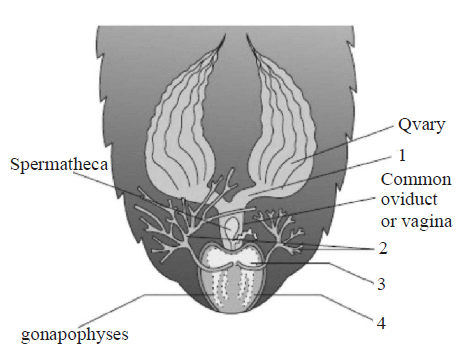
A. 1 & 2
B. 1 & 3
C. 2 & 4
D. 3 & 4
Answer : D

A. 1 & 2
B. 1 & 3
C. 2 & 4
D. 3 & 4
Answer : D
2. The frog never drinks water but absorbs it through one of its respiratory organ. Identify the organ.
A. Skin
B. Lung
C. Buccal cavity
D. None of the above.
Answer : A
A. Skin
B. Lung
C. Buccal cavity
D. None of the above.
Answer : A
3. The given figure shows open circulatory system of cockroach with structure marked as A, B and C. Which structure is a 13 pair of wing shaped involuntary muscles and mantain blood circulation?

A. A
B. B
C. C
D. Both A nad B
Answer : C

A. A
B. B
C. C
D. Both A nad B
Answer : C
4. Which of the following type of muscle tissue is being described on the basis of given statements ?
A. Skeletal muscle
B. Smooth muscle
C. Cardiac muscle
D. All of these
Answer : B
- These muscle fibres taper at both ends and do not show striations.
- The wall of internal organs such as the blood vessels, stomach and intestine contain this type of muscle tissue.
- They are involuntary as their function cannot be directly controlled.
A. Skeletal muscle
B. Smooth muscle
C. Cardiac muscle
D. All of these
Answer : B
5. Which of the following statement(s) is/are correct regarding cockroaches ?
A. Both (i) and (ii)
B. Both (ii) and (iii)
C. Both (i) and (iv)
D. All of these
Answer : C
- The body of the cockroach is segmented and divisible into three distinct regions head, thorax and abdomen.
- Blood vascular system is of closed type.
- They are monoecious and both sexes have well developed reproductive organs.
- The development of P. americana is paurometabolus, meaning there is development through nymphal stage.
A. Both (i) and (ii)
B. Both (ii) and (iii)
C. Both (i) and (iv)
D. All of these
Answer : C
6. In cockroach head can move in all directions due to
A. absence of neck.
B. fusion of all 6 segments of head.
C. flexible neck.
D. head is small and light weight.
Answer : C
A. absence of neck.
B. fusion of all 6 segments of head.
C. flexible neck.
D. head is small and light weight.
Answer : C
7. The chondrocytes of connective tissue are
A. fibre secreting cells
B. bone forming cells
C. cartilage cells
D. bone eating cells
Answer : C
A. fibre secreting cells
B. bone forming cells
C. cartilage cells
D. bone eating cells
Answer : C
8. Find the incorrectly matched pair.
A. Unicellular glandular cells - Goblet cell
B. Saliva - Exocrine secretion
C. Fusiform fibres - Smooth muscle
D. Cartilage - Areolar tissue
Answer : D
A. Unicellular glandular cells - Goblet cell
B. Saliva - Exocrine secretion
C. Fusiform fibres - Smooth muscle
D. Cartilage - Areolar tissue
Answer : D
9. The only type of cell seen in a tendon is
A. muscle fibres
B. reticular cells
C. collagenous cells
D. fibroblasts
Answer : D
A. muscle fibres
B. reticular cells
C. collagenous cells
D. fibroblasts
Answer : D
10. Which of the following types of connective tissue is mismatched with its matrix ?
A. Areolar Loosely packed matrix of protein fibres
B. Bone Mineralized matrix
C. Cartilage Highly vascular matrix
D. Blood Liquid matrix
Answer : C
A. Areolar Loosely packed matrix of protein fibres
B. Bone Mineralized matrix
C. Cartilage Highly vascular matrix
D. Blood Liquid matrix
Answer : C
11. The shape of a persons ear is due to mainly to
A. dense regular connective tissue
B. dense irregular connective tissue
C. elastic cartilage
D. fibrocartilage
Answer : C
A. dense regular connective tissue
B. dense irregular connective tissue
C. elastic cartilage
D. fibrocartilage
Answer : C
12. Read the following statements and answer the question.
Which of the following characteristics of tissue is being described by the above statements ?
A. Squamous epithelium
B. Columnar epithelium
C. Ciliated epithelium
D. Compound epithelium
Answer : A
- It is made of a single thin layer of flattened cells with irregular boundaries.
- They are found in the walls of blood vessels and air sacs of lungs.
- They are involved in functions like forming a diffusion boundary.
Which of the following characteristics of tissue is being described by the above statements ?
A. Squamous epithelium
B. Columnar epithelium
C. Ciliated epithelium
D. Compound epithelium
Answer : A
13. If the head of cockroach is cut off, it will still alive for as long as one week. It is because of
A. the body which is covered with a hard chitinous exoskeleton.
B. head which holds a bit of nervous system.
C. head which is of no use.
D. food capturing appratus which is found elsewhere.
Answer : C
A. the body which is covered with a hard chitinous exoskeleton.
B. head which holds a bit of nervous system.
C. head which is of no use.
D. food capturing appratus which is found elsewhere.
Answer : C
14. A student was given a sample of two tissues. He observes the tissues under the microscope and draws their figures (1 and 2) as shown below.
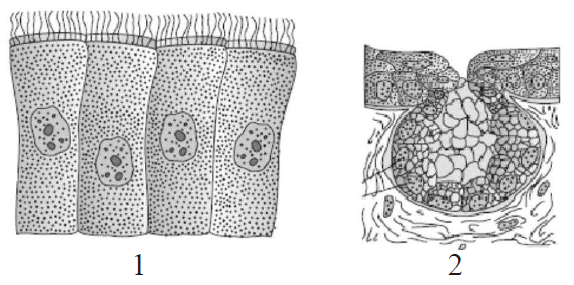
Identify the tissues (1 and 2).
A. 1: Columnar cells bearing cilia; 2: Unicellular glandular epithelium
B. 1: Cuboidal cells bearing cilia; 2: Multicellular glandular epithelium
C. 1: Compound cells bearing cilia; 2: Unicellular glandular epithelium
D. 1: Columnar cells bearing cilia; 2: Multicellular glandular epithelium
Answer : D

Identify the tissues (1 and 2).
A. 1: Columnar cells bearing cilia; 2: Unicellular glandular epithelium
B. 1: Cuboidal cells bearing cilia; 2: Multicellular glandular epithelium
C. 1: Compound cells bearing cilia; 2: Unicellular glandular epithelium
D. 1: Columnar cells bearing cilia; 2: Multicellular glandular epithelium
Answer : D
15. Statement 1 : Cartilage (protein matrix) and bone (calcium matrix) are rigid connective tissue.
Statement 2 : Blood is connective tissue in which plasma is the matrix.
A. Statement- 1 and statement-2 are true and statement-2 is a correct explanation for statement -1
B. Statement -1 and statement-2 are true and statement-2 is not a correct explanation for statement -1
C. Statement - 1 is true and statement- 2 is false
D. Both the statements are false.
Answer : B
Statement 2 : Blood is connective tissue in which plasma is the matrix.
A. Statement- 1 and statement-2 are true and statement-2 is a correct explanation for statement -1
B. Statement -1 and statement-2 are true and statement-2 is not a correct explanation for statement -1
C. Statement - 1 is true and statement- 2 is false
D. Both the statements are false.
Answer : B
16. Which of the following type of tissue is being described by the given statements ?
A. Epithelial tissue
B. Connective tissue
C. Muscle tissue
D. Neural tissue
Answer : B
- They are named because of their special function of linking and supporting other tissues/organs of the body.
- They include cartilage, bone, adipose and blood.
- They provide strength, elasticity and flexibility to the tissue.
- They also screte modified polysaccharides, which accumulate between cells and fibres and act as matrix.
A. Epithelial tissue
B. Connective tissue
C. Muscle tissue
D. Neural tissue
Answer : B
17. Lack of blood supply and presence of the noncellular basement membrane are the characteristics of the
A. muscular tissue
B. fluid connective tissue
C. epithelial tissue
D. nervous tissue
Answer : C
A. muscular tissue
B. fluid connective tissue
C. epithelial tissue
D. nervous tissue
Answer : C
18. Cartilage tissues are likely to be slow in healing following an injury because
A. cartilage cells cannot reproduce.
B. they lack direct blood supplies.
C. the intercellular material is missing.
D. cartilage cells are surrounded by fluids.
Answer : B
A. cartilage cells cannot reproduce.
B. they lack direct blood supplies.
C. the intercellular material is missing.
D. cartilage cells are surrounded by fluids.
Answer : B
19. Which of the following vertebrate tissues would be an excellent source of collagen?
A. Liver
B. Nerve
C. Muscle
D. Tendon
Answer : D
A. Liver
B. Nerve
C. Muscle
D. Tendon
Answer : D
20. Which of the following statements regarding frog is not correct?
A. Fertilization is external and takes place in water.
B. External ear and tympanum can be seen externally.
C. In females the ureters and oviduct open separately in the cloaca.
D. Copulatory pad on the first digit of the fore limbs and vocal sac are present in male frog.
Answer : B
A. Fertilization is external and takes place in water.
B. External ear and tympanum can be seen externally.
C. In females the ureters and oviduct open separately in the cloaca.
D. Copulatory pad on the first digit of the fore limbs and vocal sac are present in male frog.
Answer : B
21. The major functions of loose connective tissue include
A. occupying spaces between organs and supporting epithelia.
B. supporting and surrounding blood vessels and nerves
C. cushioning organs, storing lipids and facilitating diffusion.
D. All of the above
Answer : D
A. occupying spaces between organs and supporting epithelia.
B. supporting and surrounding blood vessels and nerves
C. cushioning organs, storing lipids and facilitating diffusion.
D. All of the above
Answer : D
22. Which of the follwing statement(s) is/are correct ?
A. Only (i)
B. Both (ii) and (iii)
C. Both (i) and (ii)
D. All of the above
Answer : B
- Cockroaches are brown or black bodied animals that are included in class insecta of phylum arthropoda.
- Males bear a pair of short, thread like anal styles which are absent in females.
- Heart of cockroach consists of elongated muscular tube lying along mid dorsal line of thorax and abdomen.
- The nymph grows by moulting about 13 times to reach the adult form.
A. Only (i)
B. Both (ii) and (iii)
C. Both (i) and (ii)
D. All of the above
Answer : B
23. The given figure shows the digestive system of cockroach with few structures marked as A, B, C and D. Identify structures A to D.

A. A-Gizzard, B-Crop, C-Hepatic caecae, D-Malpighian tubules
B. A-Crop, B-Gizzard, C-Hepatic caecae, D-Malpighian tubules
C. A- Crop, B-Gizzard, C-Malpighian tubules, D-Hepatic caecae
D. A- Gizzard, B-Crop, C-Malpighian tubules, D-Hepatic caecae
Answer : B

A. A-Gizzard, B-Crop, C-Hepatic caecae, D-Malpighian tubules
B. A-Crop, B-Gizzard, C-Hepatic caecae, D-Malpighian tubules
C. A- Crop, B-Gizzard, C-Malpighian tubules, D-Hepatic caecae
D. A- Gizzard, B-Crop, C-Malpighian tubules, D-Hepatic caecae
Answer : B
24. Which of the following statement(s) is/are correct regarding respiratory system of cockroach ?
A. Only (i)
B. (i), (ii) and (iii)
C. (ii), (iii) and (iv)
D. All of these
Answer : C
- It consists of a network of trachea, that open through 12 pairs of small holes called spiracles present on the lateral side of the body.
- Thin branching tubes carry oxygen from the air to all the parts.
- The opening of the spiracles is regulated by sphincters.
- Exchange of gases take place at the tracheoles by diffusion.
A. Only (i)
B. (i), (ii) and (iii)
C. (ii), (iii) and (iv)
D. All of these
Answer : C
25. Which of the following statement(s) regarding cell junctions is/are correct ?
A. Tight junctions help to stop substances from leaking across a tissue.
B. Adhering junctions perform cementing to keep neighbouring cells together.
C. Gap junctions facilitate the cells to communicate with each other by connecting the cytoplasm of adjoining cells, for rapid transfer of ions, small molecules and sometimes big molecules.
D. All of the above
Answer : D
A. Tight junctions help to stop substances from leaking across a tissue.
B. Adhering junctions perform cementing to keep neighbouring cells together.
C. Gap junctions facilitate the cells to communicate with each other by connecting the cytoplasm of adjoining cells, for rapid transfer of ions, small molecules and sometimes big molecules.
D. All of the above
Answer : D
26. Which of the following statement is/are correct regarding digestive system of cockroach ?
A. Only (i)
B. Both (ii) and (iii)
C. Both (i) and (iv)
D. All of these
Answer : D
- Mouth opens into a short tubular pharynx, leading to a narrow tubular passage called oesophagus.
- Gizzard helps in grinding the food particles.
- A ring of 6-8 blind tubules called hepatic or gastric caecae is present at the junction of foregut and midgut, which secrete digestive juice.
- At the junction of midgut and hindgut is present another ring of 100-150 yellow coloured thin filamentous malphigian tubules which help in removal of excretory products from haemolymph.
A. Only (i)
B. Both (ii) and (iii)
C. Both (i) and (iv)
D. All of these
Answer : D
27. Non-ciliated simple columnar epithelium often contains _______, which increase the surface area for secretion and absorption.
A. flagella
B. collagen fibres
C. microvilli
D. all of these
Answer : C
A. flagella
B. collagen fibres
C. microvilli
D. all of these
Answer : C
28. Nervous tissue cells that play several supporting roles but do not transmit impulses are called
A. glial cells
B. dendrites
C. nerve cells
D. neurons
Answer : A
A. glial cells
B. dendrites
C. nerve cells
D. neurons
Answer : A
29. The diagram given below represents the reproductive organ of male cockroach. Choose the correct labelling of the part of marked as A, B, C and D.
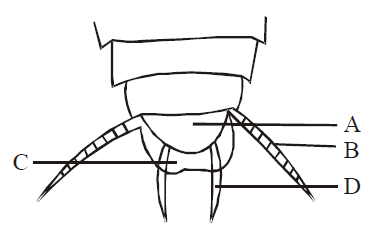
A. A 8th sternum, B - Anal cercus, C - 10th tergum, D - Anal style
B. A - 10th tergum, B - Anal cercus, C - Anal style, D - 8th sternum
C. A - Anal style, B - Anal cercus, C - 10th tergum, D- 8th sternum
D. A - Anal cercus, B - 8th sternum, C - 10th tergum, D - Anal style.
Answer : A

A. A 8th sternum, B - Anal cercus, C - 10th tergum, D - Anal style
B. A - 10th tergum, B - Anal cercus, C - Anal style, D - 8th sternum
C. A - Anal style, B - Anal cercus, C - 10th tergum, D- 8th sternum
D. A - Anal cercus, B - 8th sternum, C - 10th tergum, D - Anal style.
Answer : A
30. Match the epithetial tissue given in column-I with its location given in column-II and choose the correct option.
A. A V; B IV; C II; D III; E I
B. A III; B IV; C V; D II; E I
C. A V; B IV; C III; D II; E I
D. A III; B IV; C V; D I; E II
Answer : C
| Column I | Column II |
|---|---|
| (Epithelial tissue) | (Location) |
| A. Cuboidal | I. Epidermis of skin |
| B. Ciliated | II. Inner lining of blood vessels |
| C. Columnar | III. Inner surface of gall bladder |
| D. Squamous | IV. Inner lining of fallopian tube |
| E. Keratinized | td>V. Lining of pancreatic duct squamous
A. A V; B IV; C II; D III; E I
B. A III; B IV; C V; D II; E I
C. A V; B IV; C III; D II; E I
D. A III; B IV; C V; D I; E II
Answer : C
31. Match column-I (type of epithelium) with column-II (Description) and choose the correct option.
A. A IV; B I; C III; D II
B. A I; B IV; C III; D II
C. A IV; B I; C II; D III
D. A IV; B III; C I; D II
Answer : B
| Column-I | Column-II |
|---|---|
| (Types of epithelium) | (Description) |
| A. Squamous | I. It is composed of a epithelium single-layer of cube-like cells |
| B. Cuboidal | II. Having cilia on their free epithelium surface |
| C. Columnar | III. It is composed of a single epithelium layer of tall and slender cells |
| D. Ciliated | IV. It is made up of a single thin epithelium layer of flattened cells with irregular boundaries |
A. A IV; B I; C III; D II
B. A I; B IV; C III; D II
C. A IV; B I; C II; D III
D. A IV; B III; C I; D II
Answer : B
32. The following figure shows the extarnal features of cockroach with few structures labelled as A, B, C, D, & E. Identify A to E .
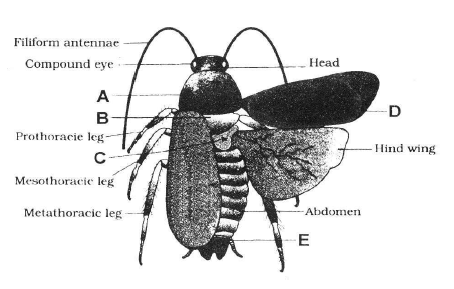
A. A- Mesothorax, B-Pronotum, C-Metathorax, D-Tegmina, E-Anal style
B. A- Pronotum, B-Metathorax, C-Mesothorax, D-Tegmina, E-Sterna
C. A- Pronotum, B-Mesothorax, C-Metathorax, D-Tegmina, E-Anal cerci
D. A- Pronotum, B-Mesothorax, C-Metathorax, D-Tegmina, E-Anal style
Answer : C

A. A- Mesothorax, B-Pronotum, C-Metathorax, D-Tegmina, E-Anal style
B. A- Pronotum, B-Metathorax, C-Mesothorax, D-Tegmina, E-Sterna
C. A- Pronotum, B-Mesothorax, C-Metathorax, D-Tegmina, E-Anal cerci
D. A- Pronotum, B-Mesothorax, C-Metathorax, D-Tegmina, E-Anal style
Answer : C
33. Match the description given in column I with their examples given in column II and choose the correct option.
A. 1 - A, 2 - B, 3 - C, 4 - D
B. 1 - C, 2 - A, 3 - D, 4 - B
C. 1 - B, 2 - A, 3 - C, 4 - D
D. 1 - C, 2 - B, 3 - D, 4 - A
Answer : A
| Column I | Column II |
|---|---|
| (Description) | (Example) |
| 1. Aquatic respiratory | A. Skin organ |
| 2. Organ which acts | B. Ureter urogenital duct and opens into the cloaca |
| 3. A small median chamber | C. Cloaca that is used to pass faecal matter, urine and sperms to the exterior |
| 4. A triangular structure | D. Sinus venosus which joins the right atrium and receives blood through vena cava |
A. 1 - A, 2 - B, 3 - C, 4 - D
B. 1 - C, 2 - A, 3 - D, 4 - B
C. 1 - B, 2 - A, 3 - C, 4 - D
D. 1 - C, 2 - B, 3 - D, 4 - A
Answer : A
34. Which of the following animal's sensory system does not has eyes but does possess light and touch sensitive organs (receptor cells) to distinguish the light intensities and to feel the vibrations in the ground?
A. Frog
B. Snake
C. Earthworm
D. Cockroach
Answer : C
A. Frog
B. Snake
C. Earthworm
D. Cockroach
Answer : C
35. Match the terms given in column-I with their feature given in column-II and choose the correct option.
A. A IV; B II; C I; D III
B. A II; B IV; C I; D III
C. A IV; B II; C III; D I
D. A IV; B I; C II; D III
Answer : A
| Column-I | Column-II |
|---|---|
| (Terms) | (Features) |
| A. Exocrine gland | I. They help to stop substances from leaking across a tissue |
| B. Endocrine gland | II. Hormones are secreted directly into the fluid bathing the gland |
| C. Tight junctions | III. They perform cementing to keep neighbouring cells together. |
| D. Adhering junctions | IV. Secretes mucus, saliva, earwax, oil, milk, digestive enzymes and other cell products |
A. A IV; B II; C I; D III
B. A II; B IV; C I; D III
C. A IV; B II; C III; D I
D. A IV; B I; C II; D III
Answer : A
36. Which of the following statements is not correct regarding neural tissue ?
A. It exerts the greatest control over the bodys responsiveness to changing conditions.
B. Chondrocytes, the unit of neural system are excitable cells.
C. Neuroglial cells protect and support neurons.
D. When a neuron is suitably stimulated, an electrical disturbance is generated.
Answer : B
A. It exerts the greatest control over the bodys responsiveness to changing conditions.
B. Chondrocytes, the unit of neural system are excitable cells.
C. Neuroglial cells protect and support neurons.
D. When a neuron is suitably stimulated, an electrical disturbance is generated.
Answer : B
37. When cardiac muscle cells are damaged by a heart attack, they are usually replaced by
A. connective tissue cells
B. new smooth muscle cells
C. new cardiac muscle cells
D. epithelial cells
Answer : A
A. connective tissue cells
B. new smooth muscle cells
C. new cardiac muscle cells
D. epithelial cells
Answer : A
38. Which of the following animals maintain ecological balance?
A. Frog
B. Rabbit
C. Earthworm
D. Cockroach
Answer : A
A. Frog
B. Rabbit
C. Earthworm
D. Cockroach
Answer : A
39. Identify the figure with its correct function Fig :. Adipose connective tissue
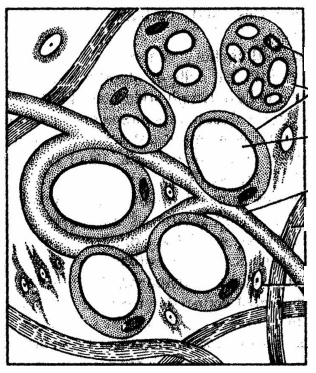
A. Areolar connective tissue Serves as a support framework for epithelium.
B. Adipose tissue Store fats and act as heat insulators.
C. Dense regular tissue Provide flexibility.
D. Dense irregular tissue Provide strength and elasticity.
Answer : B

A. Areolar connective tissue Serves as a support framework for epithelium.
B. Adipose tissue Store fats and act as heat insulators.
C. Dense regular tissue Provide flexibility.
D. Dense irregular tissue Provide strength and elasticity.
Answer : B
40. Statement 1: Typhlosole increases the effective area of absorption in the intestine.
Statement 2: Typhlosole, present in the intestine, is the characteristic feature of cockroach.
A. Statement 1 and 2 are true and statement 2 is the correct explanation of statement 1.
B. Statement 1 and 2 are true and statement 2 is not the correct explanation of statement 1.
C. Both statements 1 and 2 are false.
D. Statement 1 is true and statement 2 is false.
Answer : D
Statement 2: Typhlosole, present in the intestine, is the characteristic feature of cockroach.
A. Statement 1 and 2 are true and statement 2 is the correct explanation of statement 1.
B. Statement 1 and 2 are true and statement 2 is not the correct explanation of statement 1.
C. Both statements 1 and 2 are false.
D. Statement 1 is true and statement 2 is false.
Answer : D
41. Three essential components of most neurons are
A. simple epithelium, extracellular matrix and nerves.
B. axon, dendrites and cell body.
C. nerve cells, synapse and neuroglia.
D. mylein sheeth, node of Ranvier and Schwann cells.
Answer : B
A. simple epithelium, extracellular matrix and nerves.
B. axon, dendrites and cell body.
C. nerve cells, synapse and neuroglia.
D. mylein sheeth, node of Ranvier and Schwann cells.
Answer : B
42. Identify figures-I and II.

Figure I Figure II
A. Dense regular Dense irregular connective tissue, connective tissue
B. Loose irregular Loose regular connective tissue, connective tissue
C. Adipose tissue, Specialized connective tissue
D. Connective tissue Areolar tissue proper
Answer : A

Figure I Figure II
A. Dense regular Dense irregular connective tissue, connective tissue
B. Loose irregular Loose regular connective tissue, connective tissue
C. Adipose tissue, Specialized connective tissue
D. Connective tissue Areolar tissue proper
Answer : A
43. Phallic rgans in cockroach are related to
A. male excretory system.
B. male reproductive system.
C. female excretory system.
D. female reproductive system.
Answer : B
A. male excretory system.
B. male reproductive system.
C. female excretory system.
D. female reproductive system.
Answer : B
44. The following figures A, B and C are types of muscle tissue. Identify A, B and C.
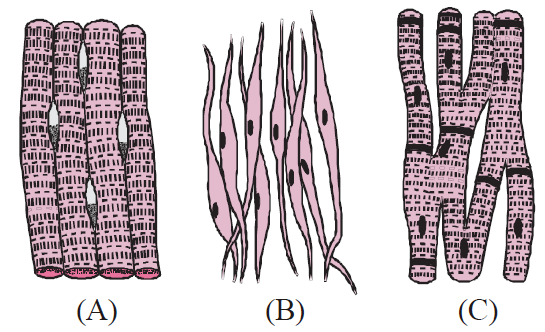
A. A Smooth muscle, B Cardiac muscle, C Skeletal muscle
B. A Skeletal muscle, B Smooth muscle, C Cardiac muscle
C. A Cardiac muscle, B Smooth muscle, C Skeletal muscle
D. A Smooth muscle, B Skeletal muscle , C Cardiac muscle
Answer : B

A. A Smooth muscle, B Cardiac muscle, C Skeletal muscle
B. A Skeletal muscle, B Smooth muscle, C Cardiac muscle
C. A Cardiac muscle, B Smooth muscle, C Skeletal muscle
D. A Smooth muscle, B Skeletal muscle , C Cardiac muscle
Answer : B
45. The mouth parts of cockroach are
A. cutting and biting type.
B. piercing and sucking type.
C. sucking and rasping type.
D. sucking and siphoning type.
Answer : A
A. cutting and biting type.
B. piercing and sucking type.
C. sucking and rasping type.
D. sucking and siphoning type.
Answer : A
46. The blood of cockroach contains no respiratory pigment. It means that
A. cockroach does not respire.
B. respiration is anaerobic.
C. oxygen goes directly into tissues by diffusion.
D. oxygen goes directly into tissues by intracellular capillary system.
Answer : D
A. cockroach does not respire.
B. respiration is anaerobic.
C. oxygen goes directly into tissues by diffusion.
D. oxygen goes directly into tissues by intracellular capillary system.
Answer : D
47. The figure given below shows the head region of cockroach. Identify A to F.
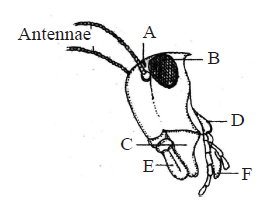
A. A- Compound eye, B-Ocellus, C-Maxilla, D-Mandible, E-Labrum, F-Labium
B. A- Ocellus, B-Compound eye, C-Mandible, D-Maxilla, E-Labrum, F-Labium
C. A- Ocellus, B-Compound eye, C-Mandible, D-Maxilla, E-Labium, F-Labrum
D. A- Ocellus, B-Compound eye, C-Maxilla, D-Mandible, E-Labrum, F-Labium
Answer : B

A. A- Compound eye, B-Ocellus, C-Maxilla, D-Mandible, E-Labrum, F-Labium
B. A- Ocellus, B-Compound eye, C-Mandible, D-Maxilla, E-Labrum, F-Labium
C. A- Ocellus, B-Compound eye, C-Mandible, D-Maxilla, E-Labium, F-Labrum
D. A- Ocellus, B-Compound eye, C-Maxilla, D-Mandible, E-Labrum, F-Labium
Answer : B
48. In the given diagram of areolar connective tissue, the different cells and parts have been marked by alphabets (A, B, C & D). Choose the answer in which these alphabets correctly match with the parts and cells they indicate.

A. A-Adipocyte, B-Collagen fibres, C-Microfilament, D-Mast cells
B. A-Macrophage, B-Collagen fibres, C-Microfilament, D-Mast cells
C. A-Macrophage, B-Collagen fibres, C-Microtubule, D-RBC
D. A-Macrophage, B-Fibroblast, C-Collagen fibres, D-Mast cells
Answer : D

A. A-Adipocyte, B-Collagen fibres, C-Microfilament, D-Mast cells
B. A-Macrophage, B-Collagen fibres, C-Microfilament, D-Mast cells
C. A-Macrophage, B-Collagen fibres, C-Microtubule, D-RBC
D. A-Macrophage, B-Fibroblast, C-Collagen fibres, D-Mast cells
Answer : D
49. In all connective tissues, except which of the following, the cells secretes the fibres of collagen or elastin protein ?
A. Bone
B. Cartilage
C. Areolar connective tissue
D. Fluid connective tissue
Answer : D
A. Bone
B. Cartilage
C. Areolar connective tissue
D. Fluid connective tissue
Answer : D
50. Tendons and ligaments are the examples of
A. areolar connective tissue
B. adipose tissue
C. dense regular connective tissue
D. loose connective tissue
Answer : C
A. areolar connective tissue
B. adipose tissue
C. dense regular connective tissue
D. loose connective tissue
Answer : C
Sharing is caring
Related Post
1000+ Microsoft Word Multiple Choice Question Answer [Solved]
JavaScript MCQ Solved Paper for IBPS RRB
1000+ Word Power Multiple Choice Question Answer [Solved]
Power Plant Engineering 1000+ MCQ with answer for LIC AAO
Planet Kingdom MCQ Solved Paper for SSC JE
JEE Main - Asp Programming 1000+ MCQ [Solved] PDF Download